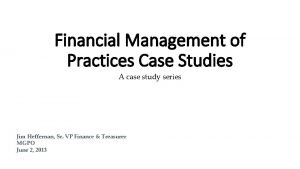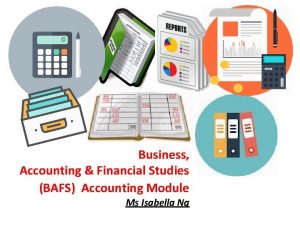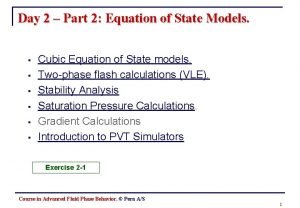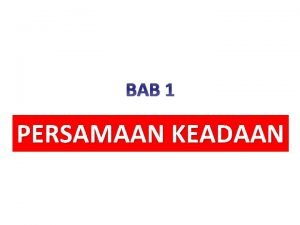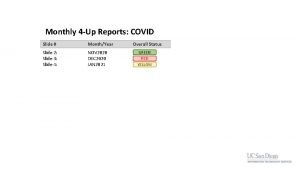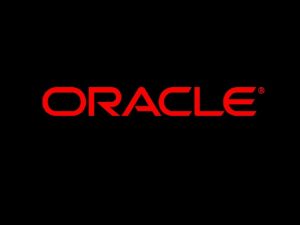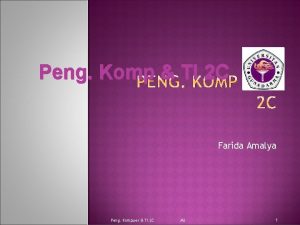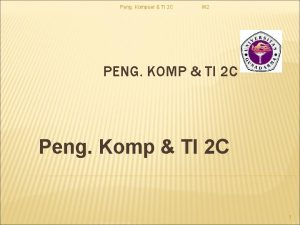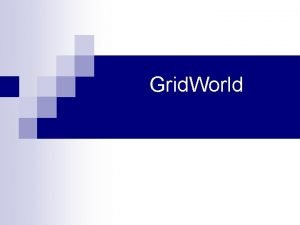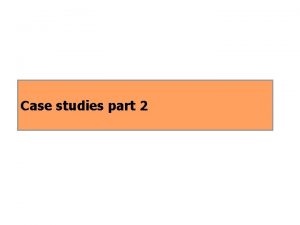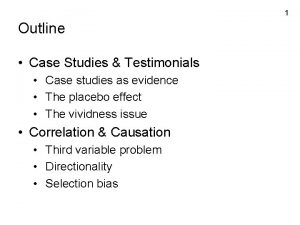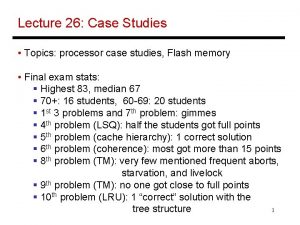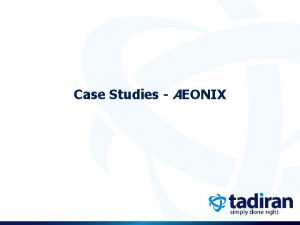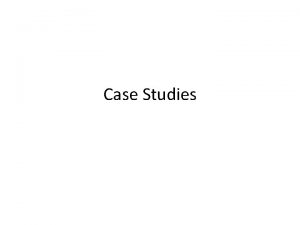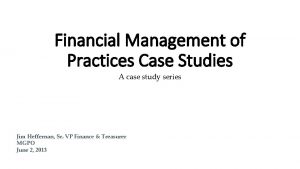Financial Engineering Principles and Case studies Michael Peng

































- Slides: 33

Financial Engineering: Principles and Case studies Michael Peng, April 28, 2005 Risk Management, Rabo Bank

Agenda What is financial engineering n Economics of Financial Engineering n Principles and methods of financial engineering n Case Studies: CDO and Credit Derivatives n An Example of Portfolio Risk Model n

The Functions of Financial Instruments Moving funds across time and space n Increasing Liquidity of assets n Addressing asymmetric information (moral hazard) and reducing agency cost n Reallocating risk n Create Customized risk-return profile n

What is Financial Engineering? A process involving the creation and combination of a variety of financial instruments, in order achieve a defined financial objective within constraints (modeling cost, regulatory, legal, data/information, computational capacity, etc)

The Reason for Financial Engineering n Market incompleteness: “missing market” for some states of the world; costly formation of markets for some instruments n Market Imperfectness Information impactedness and asymmetry; strategic behavior; regulatory distortion of pricing

Principles of Financial Engineering n n Replication: construct a portfolio consists of liquid instruments that replicate the same cash flow of an asset under consideration Calibration: reconciling model parameters with market data Risk decomposition: Risk type must be properly identified and measured Recognizing strategic behavior: direct interaction among market players (e. g. agency issues)

Static Replication n First, we write down the cash flows generated by the asset to be replicated Next, we decompose these cash flows in order to recreate some (liquid) assets such that a vertical addition of the new cash flows match those of the targeted asset Financially, we have to make sure that the (credit) risks of the targeted asset and proposed synthetic are indeed the same.

A simple example of pricing by replication Replicating currency forward contract using loan and spot market +100 USD t 0 t 1 Add a positive EUR cash flow (Take a loan in Euro) -100/Ft 0 EUR t 0 t 1 t 0 Add a negative USD cash flow (Deposit in dollars) t 1

Basic Tenets of Replication n All financial instruments can be visualized as bundles of cash flows with different attributes and risk feature Cash flow can be replicated (using other simpler, liquid instruments) and repackaged to create “synthetic” instruments Everything else being the same, a replicating portfolio must have the same price as the original instrument---if there is no credit risk, no transaction costs, and if the markets in all the involved instruments are liquid, we expect that arbitrage will make the value of the two portfolio equal in equation.

A pricing example using liquid instruments with observable price in the market FX Forward pricing formula Note: that it expresses the “unknown” Ft 0 as a function of variables that can be observed at time t 0. Hence, using the market quotes and does not require any forecasting effort. In fact, bringing in a forecasting model to determine the Ft 0 will lead to the wrong market price and may create arbitrage opportunities.

A Contractual Equation FX Forward Buy USD Against EUR Loan = Borrow EUR at t 0 for maturity t 1 Deposit Spot Operation + Buy USD against EUR + Deposit USD at t 0 For maturity t 1 The expression shown above is a contractual equation. The left -hand side contract leads to the same cash flows generated jointly by the contracts on the right-hand side.

Derivation of Black_Scholes Formula: A Financial Engineering Perspective (1) Black-Scholes model is to give a closed form price for option. It’s derivation is quite inspiring from the perspective of financial engineering. It achieve its neat formula via a noarbitrage or delta-hedging argument; In essence, it replicate risk free-free portfolio and establish a “contractual equation” in which the value of the option is embedded. As in the model assumptions above we assume that the underlying (typically the stock) follows a geometric Brownian motion. That is, where W is Brownian. Now let V be some sort of option on S – mathematically, V (S, t)is a function of S and t.

Derivation of Black_Scholes Formula: A Financial Engineering Perspective (2) Now let V be some sort of option on S – mathematically V (S, t)is a function of S and t. By Itô's lemma for two variables we have Now consider a portfolio Π consisting of one unit of the option V and -d. V/d. S units of the underlying. The composition of this portfolio, called the delta-hedge portfolio, will vary from time-step to time-step.

Derivation of Black_Scholes Formula: A Financial Engineering Perspective (3) Now consider the change in value of the portfolio by subbing in the equation above: This equation contains no d. W term. That is, it is entirely riskless !. Thus, assuming no arbitrage (also no transaction costs and infinite supply and demand) the rate of return on this portfolio must be equal to the rate of return on any other riskless instrument. Now assuming the risk-free rate of return is r we must have over the time period [t, t + δt]. Therefore we have the contractual equation :

Derivation of Black_Scholes Formula: A Financial Engineering Perspective (4) If we now substitute in for Π and divide through by dt we obtain the well-reputed Black -Scholes PDE With the assumptions of the Black-Scholes model, this equation holds whenever V has two derivatives with respect to S and one with respect to t.

Case in Point : “CDO” as a product of Financial Engineering What is CDO? Debt Securitization n Pool of Diversified Debt Obligations is Packaged and Sold to the Capital Markets n n n The CDO Issues Multiple Layers/Tranches of Securities: Senior, Mezzanine, Equity (First Loss) Payments to CDO Tranches depend on the performance of the Underlying Portfolio of Assets Underlying Portfolio can be - Real or Synthetic; Actively Managed or Passive

How CDOs Address Market Imperfection issues Reduce expensive regulatory capital n Increase loan/bond value by enhancing liquidity and mitigating information asymmetry: n

Issues in CDO creation • Adverse selection • Structuring cost • Moral hazard

Cashflow Arbitrage CDO: Example n Motivation: Spread Arbitrage n Portfolio (loans/bonds) is sourced from the market and purchased by the SPV, which is a transparent, bankruptcy-remote entity used to segregate the assets from the originator. n SPV funds the purchase by issuing debt n The spread between the portfolio (Assets) is greater than the spread on the Debt (Liabilities). Tranching the debt to target investors with different risk appetites achieves the cheapest Liability cost.

Finding a fair market price for non-traded instruments n n n Step 1: construct a synthetic equivalent to this instrument, using liquid contracts traded in market Step 2: use arbitrage argument: Value (replicating portfolio) =Value(instrument to be priced) Step 3 A trader would add a proper margin(which may include transaction cost) to get the fair price. Note: this pricing approach is quite useful for the creation of “ new product”. A new product is basically a series of contigent cash flows. We would first, put together a combination of financial instruments that have the same cash flow , Then, we would write a separate contract and sell these cash flows to others under a new name.

Generic CDO Structure Collateral Manager Diversified Pool of Underlying Assets (Collateral) CDO Special Purpose Vehicle (SPV) Senior Fixed or Floating Rate Notes Mezzanine Fixed or Floating Rate Notes Subordinated Notes Equity

How are the debt tranches sized and rated? n The rating agencies assign a default probability and loss severity for each rating category depending on the credit quality of the collateral pool. n Default probability is based on historical default studies of corporate credit. Default rates are stressed given the rating level of the tranche (eg. a AAA tranche can withstand approximately five times historical defaults). n Loss severity is also based on the rating agencies’ historical data on recoveries and depends on asset type and geographical location of the issuer (eg. lower recoveries for European collateral compared to U. S. ). Total expected loss on collateral = Default probability x (1 -recovery rate) n The total expected loss on the collateral must be accounted for by subordination, cash or other eligible collateral to achieve a target rating.

Capital Structure

Balance Sheet CDO: Example

Types of CDOs There are two broad types of CDOs: Balance Sheet and Arbitrage n The factor that differentiates the two is motivation: n Type Motivation Balance Sheet Freeing up capital from a financial institution’s balance sheet Arbitrage Taking advantage of spread arbitrage between Assets and Liabilities

CDO Advantages n Different Tranches allow Investors to customize their Credit Risk exposure n Efficient Mechanism for taking Diversified Credit Exposure n Attractive Spreads relative to similarly rated Assets

Case study: The BISTRO structure of synthetic CDO n BISTROs T R A D I T I O N A L B A N K B A L A N C E S H E E T S T O O L S are credit derivative based securitisations as a way of managing economic and regulatory capital n JPMorgan carrying a low BIS weighting as an OECD bank, guarantees a portf of corporate (or other) exposures owned by another bank, thereby re-weight them for regulatory purposes n JPMorgan often hedged some of the risk by selling a second loss portion of c 12% in the capital markets (through the issuance of notes) or over-the-coun n Benefits of BISTRO structure n No sale of underlying assets, no impact on balance sheet size or leverage r n Short execution time frame and less loan-by-loan due diligence n Less cost, management time and redesigning of internal systems than a fun securitisation BISTRO vehicle Fee for covering $10 bn Originator bank Portfolio guarantee when loss exceeding 1. 5% JPMorgan assets Fee for covering $700 m Collateral (Treasury Sub Guarantee when loss exceeding 1. 5% $700 ms liabilitie s Notes Tranched Notes 22 Capital market investors

Default Risk Models Structural model n Reduced form n Analytical (See Attached word document entitle” Implementing an analytical approach in calculating Portfolio Loss Distribution) n Simulation n

5. Measure, Monitor & Manage Portfolio Credit Risk ‘CREDIT CAPITAL’ ( Portfolio Credit Risk Management Model) The portfolio approach to credit risk management integrates the key credit risk components of assets on a portfolio basis, thus facilitating better understanding of the portfolio credit risk. The insight gained from this can be extremely beneficial both for proactive credit portfolio management and creditrelated decision making. 1. It is based on a rating (internal rating of banks/ external ratings) based methodology. RBI has in its Credit Guidance Note (Oct 2002) emphasized setting up of an internal Credit Rating Framework with rating of all instruments and facilities as the basis for credit risk management. It is primarily based on a credit rating framework and therefore can be implemented with minimal modification to Banks internal systems 2. Being based on a loss distribution (CVa. R) approach, it easily forms a part of the Integrated risk management framework.

Credit Default Swaps (CDS) n Most common credit derivative (over 50% of the market) n Provides protection against default of a reference entity (isolates credit risk component) - Protection buyer retains market exposure of reference entity Protection seller gets leveraged exposure to reference entity

A Contractual Equation for CDS Defaultable bond = A fixed receiver in interest rate swap + Risk-free deposit + CDS on the credit A defaultable bond can be decomposed into a portfolio made of (1) a fixed receiver interest swap, (2) a default-free money market deposit, and (3) a credit default swap. Here the maturities of a bond , swap, and the CDS would be the same

Modeling Default Correlation n Obligors are now correlated indirectly through a common risk factor (the ‘state of the economy’ V) n Assume return of asset of obligor i is with Xi, V Gaussian N(0, 1), Vi and V independent n Assume obligor i defaults if Xi< Ci ; hence Fi =N(Ci) n Conditional on V, the asset returns are independent

Conditional Independence Framework n Conditional on V the survival probability of obligor i is given by n Joint conditional survival probability is n Joint (unconditional) survival probability is therefore
 Financial management case studies
Financial management case studies Social engineering case studies
Social engineering case studies Best worst and average case
Best worst and average case Case western reserve university case school of engineering
Case western reserve university case school of engineering Li you and wang peng
Li you and wang peng Paradigm shift from women studies to gender studies
Paradigm shift from women studies to gender studies Business accounting and financial studies
Business accounting and financial studies Can mermaid escape love
Can mermaid escape love Peng-robinson equation of state
Peng-robinson equation of state Persamaan redlich kwong
Persamaan redlich kwong Aspen lum
Aspen lum Changnan peng
Changnan peng Contoh kes akta perkongsian 1961
Contoh kes akta perkongsian 1961 4up report
4up report Helen peng age
Helen peng age Peng
Peng Peng
Peng Ut san antonio
Ut san antonio Joyce peng
Joyce peng Zhigang peng
Zhigang peng Peng
Peng Bo peng kaggle
Bo peng kaggle Peng
Peng Peng duhai
Peng duhai Stabelaryzowane
Stabelaryzowane ютуб
ютуб Peng cui tsinghua
Peng cui tsinghua Protocol verification in computer networks
Protocol verification in computer networks Peng zhao oakland university
Peng zhao oakland university Helen peng
Helen peng An apple a day keeps the doctor away
An apple a day keeps the doctor away Example of outbreak
Example of outbreak What is case series
What is case series Non financial motivators
Non financial motivators
